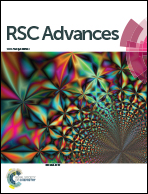Effluent of biomass cooking with active oxygen and solid alkali (CAOSA): component separation, recovery and characterization†
Abstract
Effluent from biomass pretreatment industries affects a substantial proportion of industrial wastewater and can be troublesome to treat. In a new environmentally benign biomass pretreatment approach based on cooking with active oxygen and solid alkali (CAOSA), some precipitates were found to be produced while the effluent (yellow liquor) was treated with alcohol or acid. Based on the precipitation approaches, component contents in CAOSA yellow liquor were successfully made clear, consisting of 57.19 wt% low molecular weight acid salts, 15.47 wt% lignin, 4.30 wt% saccharides and 23.04 wt% inorganic salts. Different organic solvents were tested as the precipitants, and when ethanol was used, over 81 wt% of the compounds in the yellow liquor could be precipitated. Meanwhile, 89.2% of the solid alkali consumed in CAOSA pretreatment could be recovered, showing prospects for primary effluent treatment. Furthermore, CAOSA lignin (CL) was recovered by acid precipitation from yellow liquor. By characterization, CL was found to have lower molecular weight and higher β-O-4 bond (60.05%) ratio than milled wood lignin (MWL, 48.64%), and thus, it might be a more ideal feedstock for further valorization.



 Please wait while we load your content...
Please wait while we load your content...